The Prediction of the Gas Utilization Ratio based on TS Fuzzy Neural Network and Particle Swarm Optimization
Abstract
:1. Introduction
2. Analysis of the Relevant Factors of the GUR and the Data Preprocessing
2.1. Selection of the Input Parameters of the Prediction Model
2.2. The Rejection of the Outliers of the Raw Data of the BF
3. The Parameter Correlation Analysis
3.1. Mutual Information Principle and the Generalized Correlation Coefficient
3.2. The Wavelet De-Noising
4. The Prediction Model of the GUR Based on the T-S Model
5. The Proposed PSO-TS-FNN Algorithm
5.1. The Particle Swarm Optimization Algorithm
5.2. Particle Swarm Optimization (PSO) Fuzzy Neural Network of TS Model
- Step 1:
- Initialization. Initialize the parameters and the weights.
- Step 2:
- Modeling. Establish the T-S model and calculate the learning algorithm weights based on the output error. The training error is used as the Fitness function of the particle swarm.
- Step 3:
- Update. Update the parameters and the weights. Then update the particle’s velocity and its position.
- Step 4:
- Judgment. Determine whether the number of iterations of the particle swarm reaches the maximum. If so, calculate the optimal parameters of the T-S model. If not, go back to Step 3.
- Step 5:
- The Second Judgment. Determines whether the iterations of the T-S model have reached the maximum value. If so, the modeling is over. Otherwise, go back to Step 2.
6. The Performance Comparison of Different Models
7. Conclusions
Acknowledgments
Author Contributions
Conflicts of Interest
Appendix A
| Abbreviation | Explanation |
|---|---|
| GUR | Gas utilization ratio |
| BF | blast furnace |
| FNN | fuzzy neural network |
| TS-FNN | TS fuzzy neural network |
| PSO | particle swarm algorithm |
| PSO-TS-FNN | particle swarm algorithm (PSO) to optimize the TS-FNN |
| FW | blast temperature |
| FY | blast pressure |
| DY | top pressure |
| DW | top temperature |
| O2 | enrichment percentage |
| MQLYL | GUR |
| PCC | Pearson correlation coefficient |
| SCC | Spearman correlation coefficient |
References
- Yang, K.; Choi, S.; Chung, J.; Yagi, J.I. Numerical Modeling of Reaction and Flow Characteristics in a Blast Furnace with Consideration of Layered Burden. ISIJ Int. 2010, 50, 972–980. [Google Scholar] [CrossRef]
- Zeng, J.S.; Gao, C.H.; Su, H.Y. Data-driven Predictive Control for Blast Furnace Ironmaking Process. Comput. Chem. Eng. 2010, 34, 1854–1862. [Google Scholar] [CrossRef]
- Pasquale, C.; Angelo, P. Optimization of Blast Furnace Productivity Coupled with CO2 Emissions Reduction. Steel Res. Int. 2014, 85, 89–98. [Google Scholar]
- Helle, H.; Helle, M.; Pettersson, F.; Saxen, H. Multi-objective Optimization of Ironmaking in the Blast Furnace with Top Gas Recycling. ISIJ Int. 2010, 50, 1380–1387. [Google Scholar] [CrossRef]
- Shi, L.; Wen, YB.; Zhao, G.S.; Yu, T. Recognition of Blast Furnace Gas Flow Center Distribution Based on Infrared Image Processing. J. Iron Steel Res. Int. 2016, 23, 203–209. [Google Scholar] [CrossRef]
- Zhang, H.; Zhang, S.; Yin, Y. Online Sequential ELM Algorithm with Forgetting Factor for Real Applications. Neurocomputing 2017, 261, 144–152. [Google Scholar] [CrossRef]
- Du, N. Research on Modeling of blast furnace condition prediction and gas flow distribution relationship. Master’s Thesis, Central South University, Changsha, China, 2014. [Google Scholar]
- Lahm, A.H. Calculation and Analysis of Modern Blast Furnace Process (Calculation and Analysis of Modern Blast Furnace Process); Wang, X., Translator; Metallurgical Industry Press: Beijing, China, 1987; pp. 266–289. [Google Scholar]
- Na, S. Ironmaking Calculation Analysis (Calculation and Analysis of Ironmaking); Metallurgical Industry Press: Beijing, China, 2010; pp. 161–199. [Google Scholar]
- Xiang, Z.; Wang, X.; Yin, H. More discussion on evaluation method for productive efficiency of ironmaking blast furnace. Iron Steel 2013, 48, 86–91. [Google Scholar]
- Wei, H. Analysis and practice of utilization ratio of No. 5 BF gas. In Proceedings of the Practical New Technology and Equipment of Efficient Ironmaking and Raw Material, Hangzhou, China, 16–18 April 2013; pp. 87–90. (In Chinese). [Google Scholar]
- Zhou, C. Blast Furnace Ironmaking Production of Technical Manual; Metallurgical Industry Press: Beijing, China, 2005; pp. 174–177. [Google Scholar]
- Spitzer, M.; Wildenhain, J.; Rappsilber, J.; Tyers, M. BoxPlotR: A web tool for generation of box plots. Nat. Methods 2014, 11, 121–122. [Google Scholar] [CrossRef] [PubMed]
- Hu, Z. Stratiogy for improvement in utilization ratio of No. 5 BF gas in WISCO and its practice. WISCO Technol. 2012, 50, 8–11. [Google Scholar] [CrossRef]
- An, J.; Chen, Y.; Wu, M. Prediction method of carbon monoxide utilization in blast furnace based on improved support vector machine. J. Chem. Eng. 2015, 206–214. [Google Scholar]
- Papoulis, A. Probability, Random Variables and Stochastic Processes, 2nd ed.; McGraw-Hill: New York, NY, USA, 1984. [Google Scholar]
- Jin, Z. Information Theory; Beijing Institute of Technology Press: Beijing, China, 1991; pp. 7–47. [Google Scholar]
- Deng, Y.-H.; Liu, G.-X. ATS-FNN-based modeling and simulation for compensation prediction of FWP machining deformation. J. South China Univ. Technol. 2012, 40, 146–151. [Google Scholar]
- Ishaque, K.; Salam, Z.; Amjad, M.; Mekhilef, S. An improved particle swarm optimization (PSO)–based MPPT for PV with reduced steady-state oscillation. IEEE Trans. Power Electron. 2012, 27, 3627–3638. [Google Scholar] [CrossRef]
- Lorenzo, P.R.; Nalepa, J.; Kawulok, M.; Ramos, L.S.; Ranilla Pastor, J. Particle swarm optimization for hyper-parameter selection in deep neural networks. In Proceedings of the Genetic and Evolutionary Computation Conference, Berlin, Germany, 15–19 July 2017; pp. 481–488. [Google Scholar]
- Lorenzo, P.R.; Nalepa, J.; Kawulok, M.; Ramos, L.S.; Ranilla Pastor, J. Hyper-parameter selection in deep neural networks using parallel particle swarm optimization. In Proceedings of the Genetic and Evolutionary Computation Conference, Berlin, Germany, 15–19 July 2017; pp. 1864–1871. [Google Scholar]
- Miyatake, M.; Veerachary, M.; Toriumi, F.; Fujii, N.; Ko, H. Maximum power point tracking of multiple photovoltaic arrays: A PSO approach. IEEE Trans. Aerosp. Electron. Syst. 2011, 47, 367–380. [Google Scholar] [CrossRef]
- Garro, B.A.; Vazques, R.A. Designing Artificial Neural Networks Using Particle Swarm Optimization Algorithms. Comput. Int. Neurosci. 2015, 2015, 61. [Google Scholar] [CrossRef] [PubMed]
- Jin, C.; Chang, G.; Cheng, W.; Jiang, H. Improved Particle Swarm Optimization for Fuzzy Neural Network Traning. In Proceedings of the 2011 Fifth International Conference on Genetic and Evolutionary Computing, Xiamen, China, 29 August–1 September 2011; pp. 299–302. [Google Scholar]
- Hyndman, R.J.; Koehler, A.B. Another look at measures of forecast accuracy. Int. J. Forecast. 2006, 22, 679–688. [Google Scholar] [CrossRef]
- Chai, T.; Draxler, R. Root mean square error (RMSE) or mean absolute error (MAE)?–Arguments against avoiding RMSE in the literature. Geosci. Model Dev. 2014, 7, 1247–1250. [Google Scholar] [CrossRef]
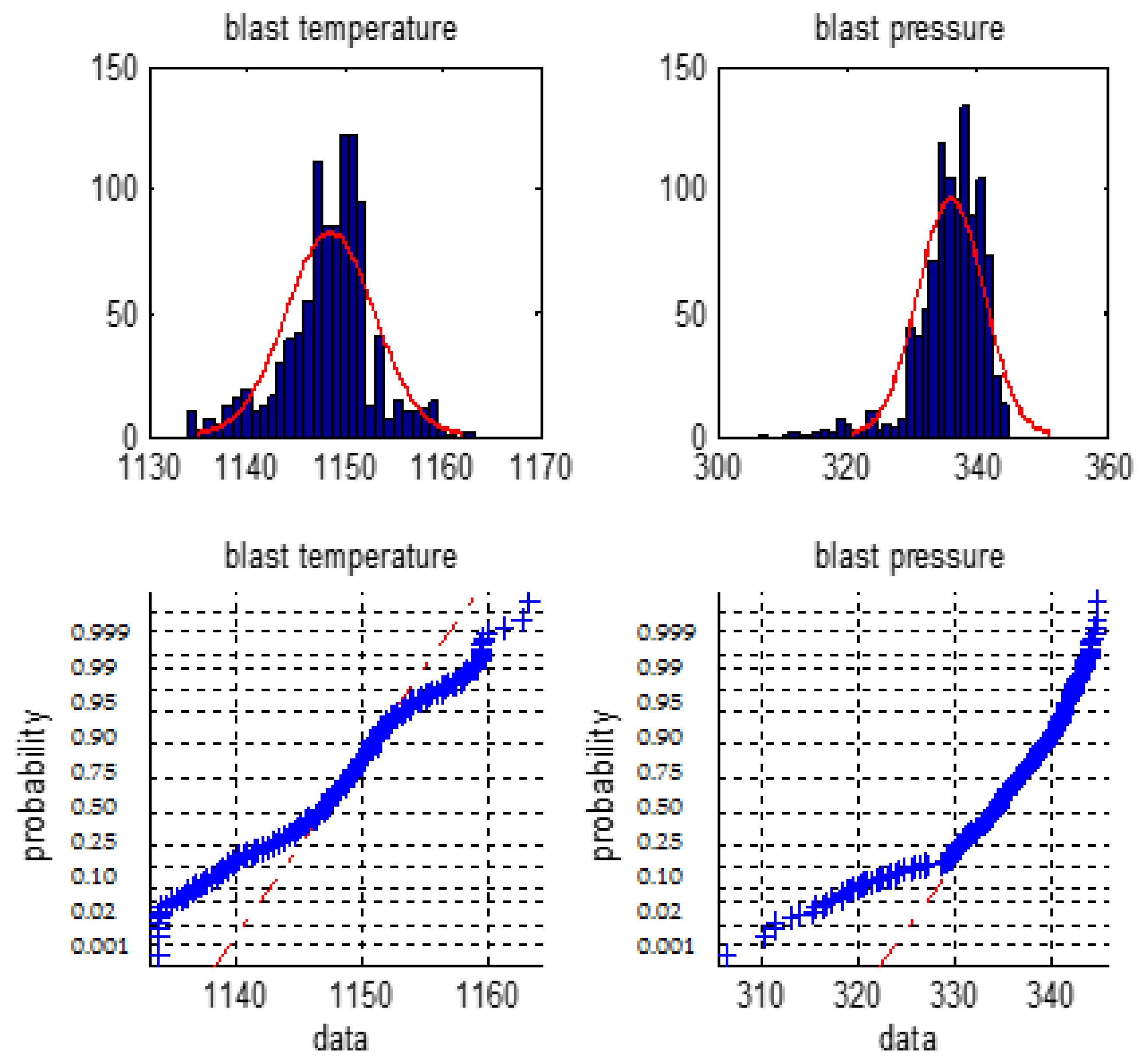

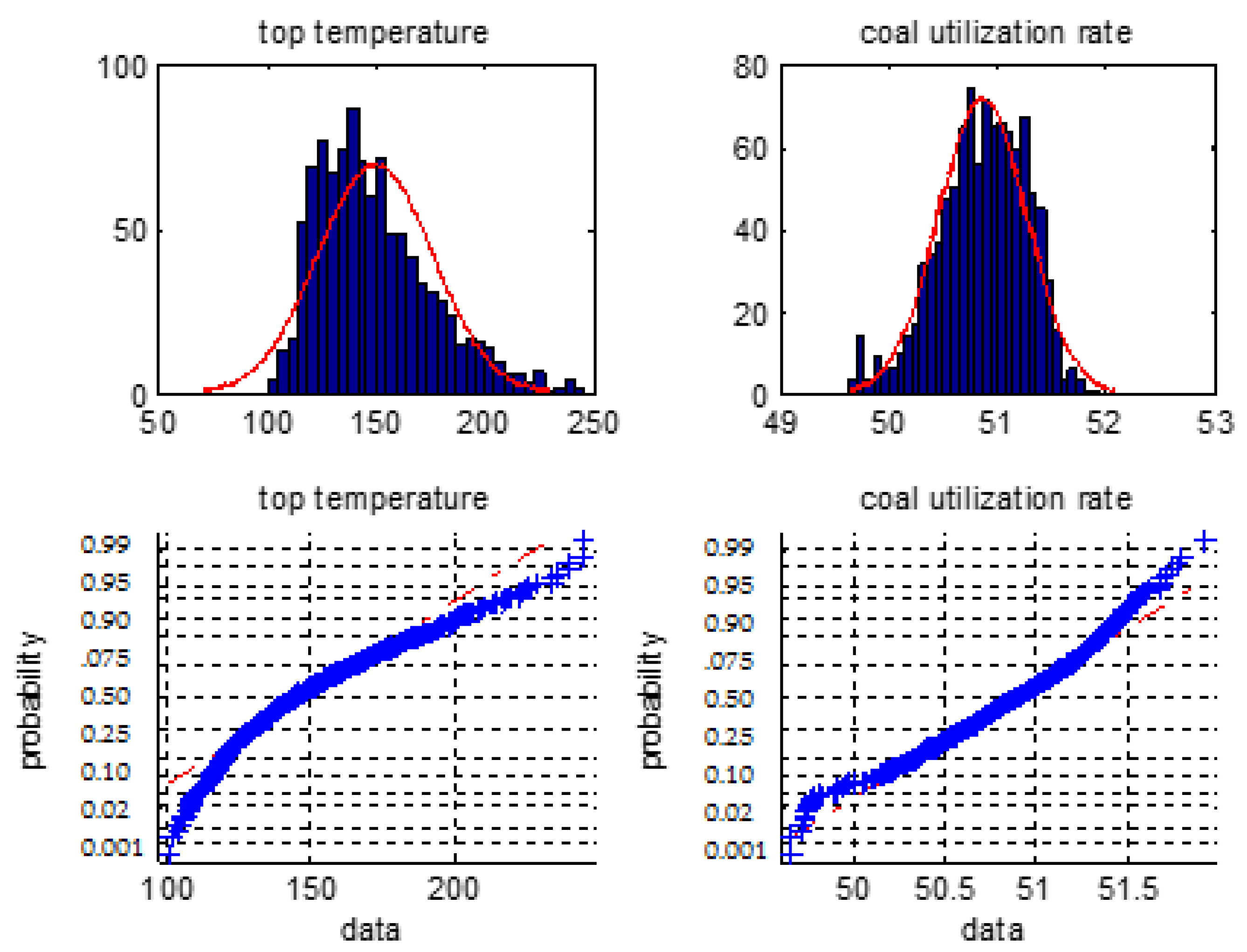
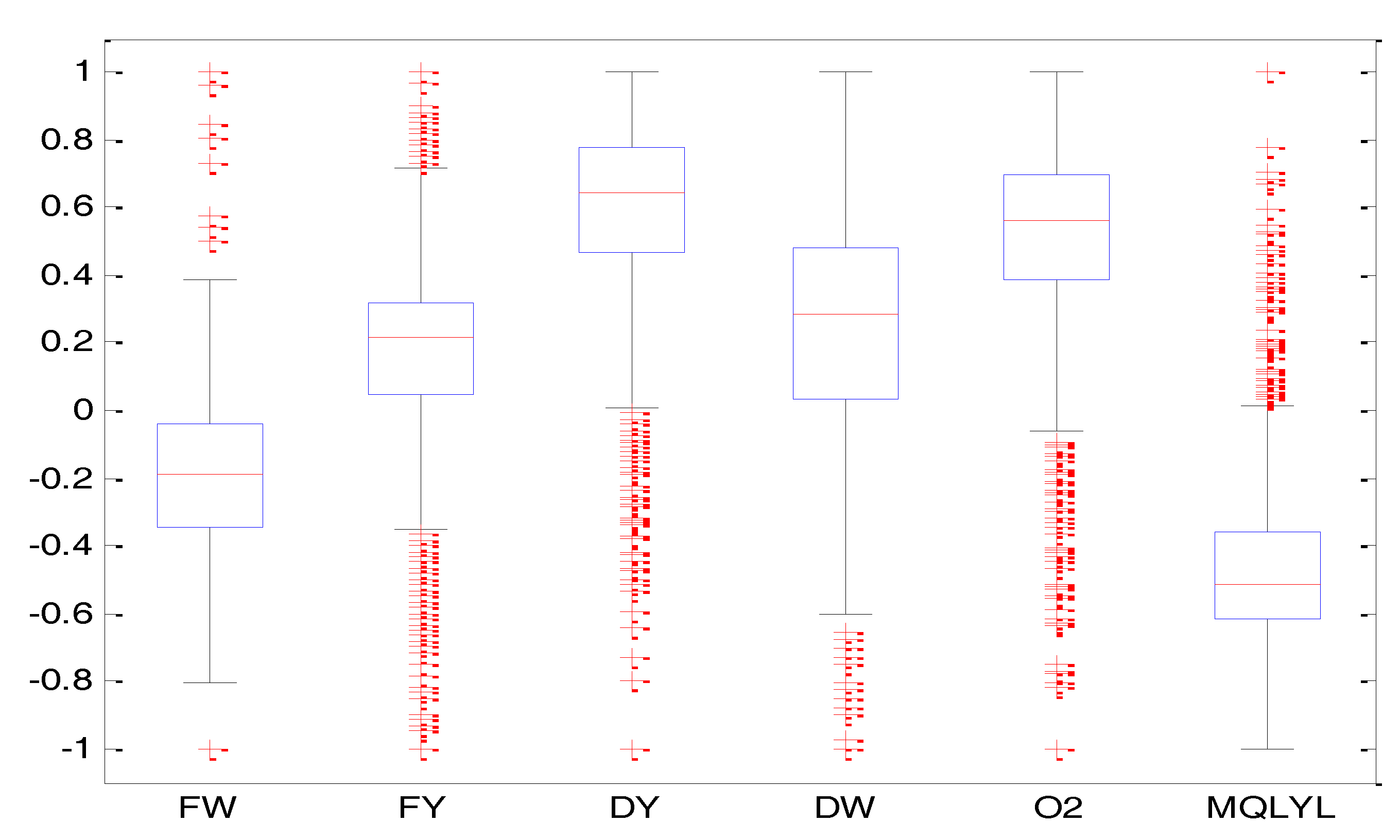
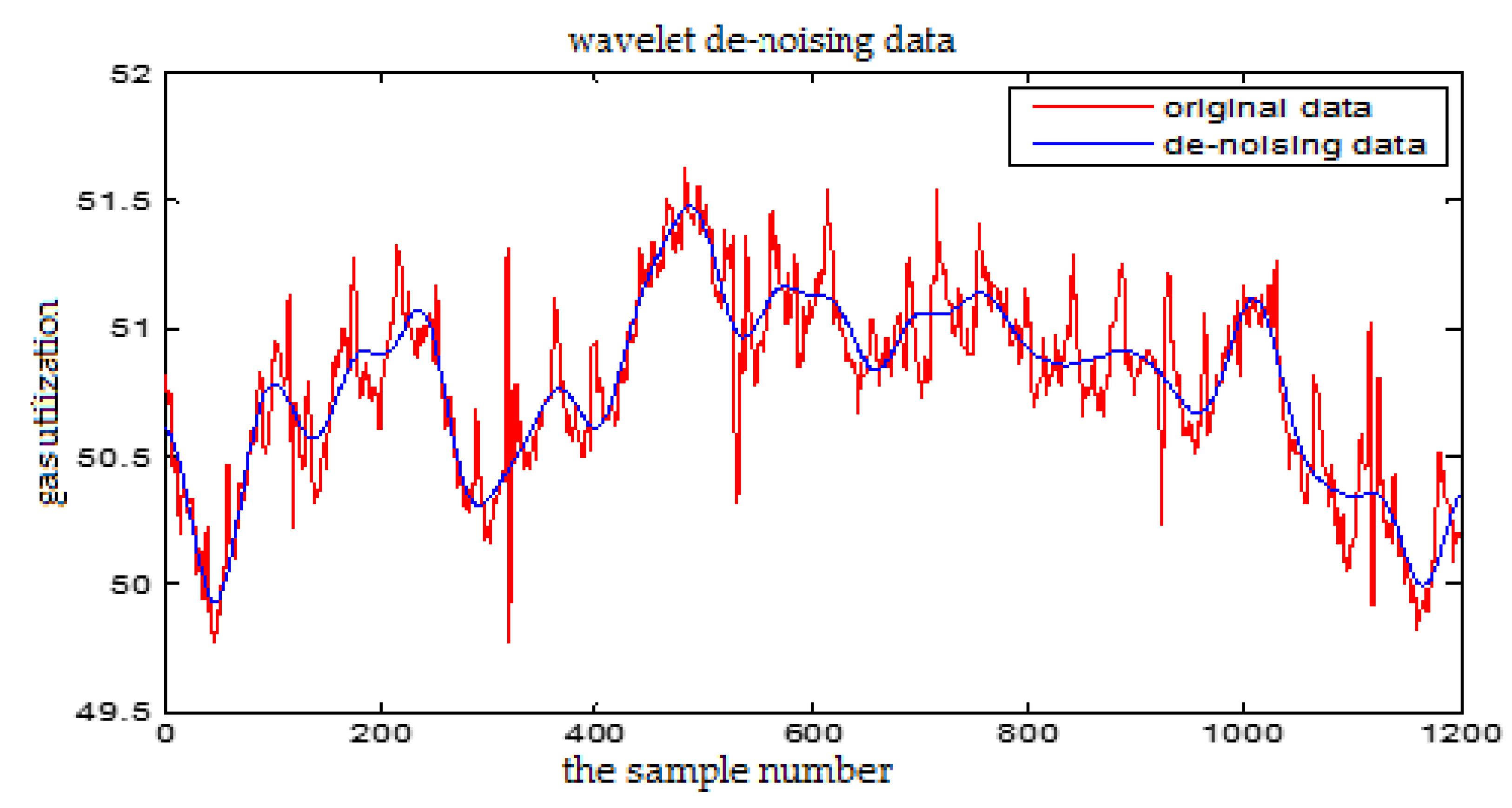
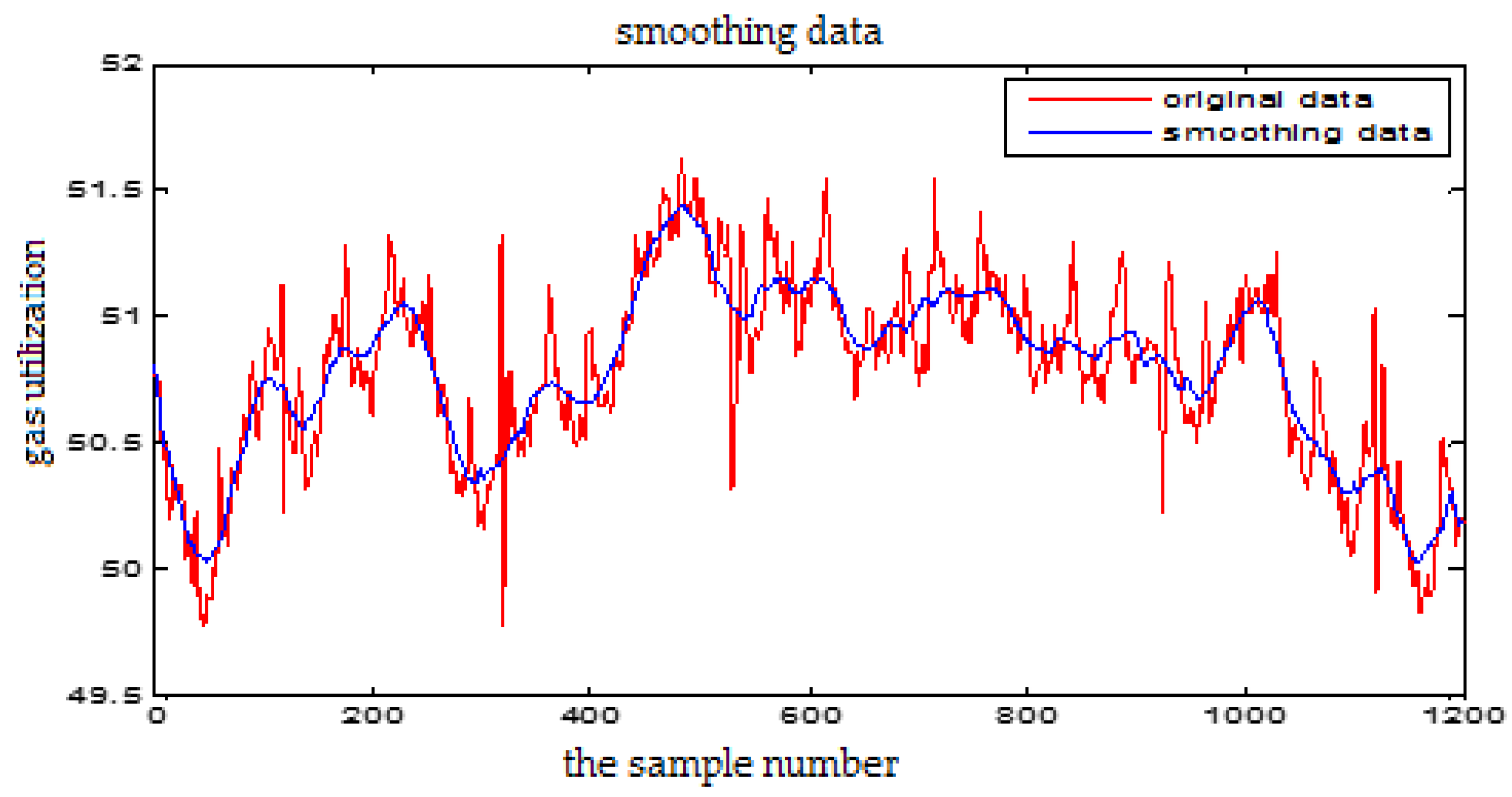
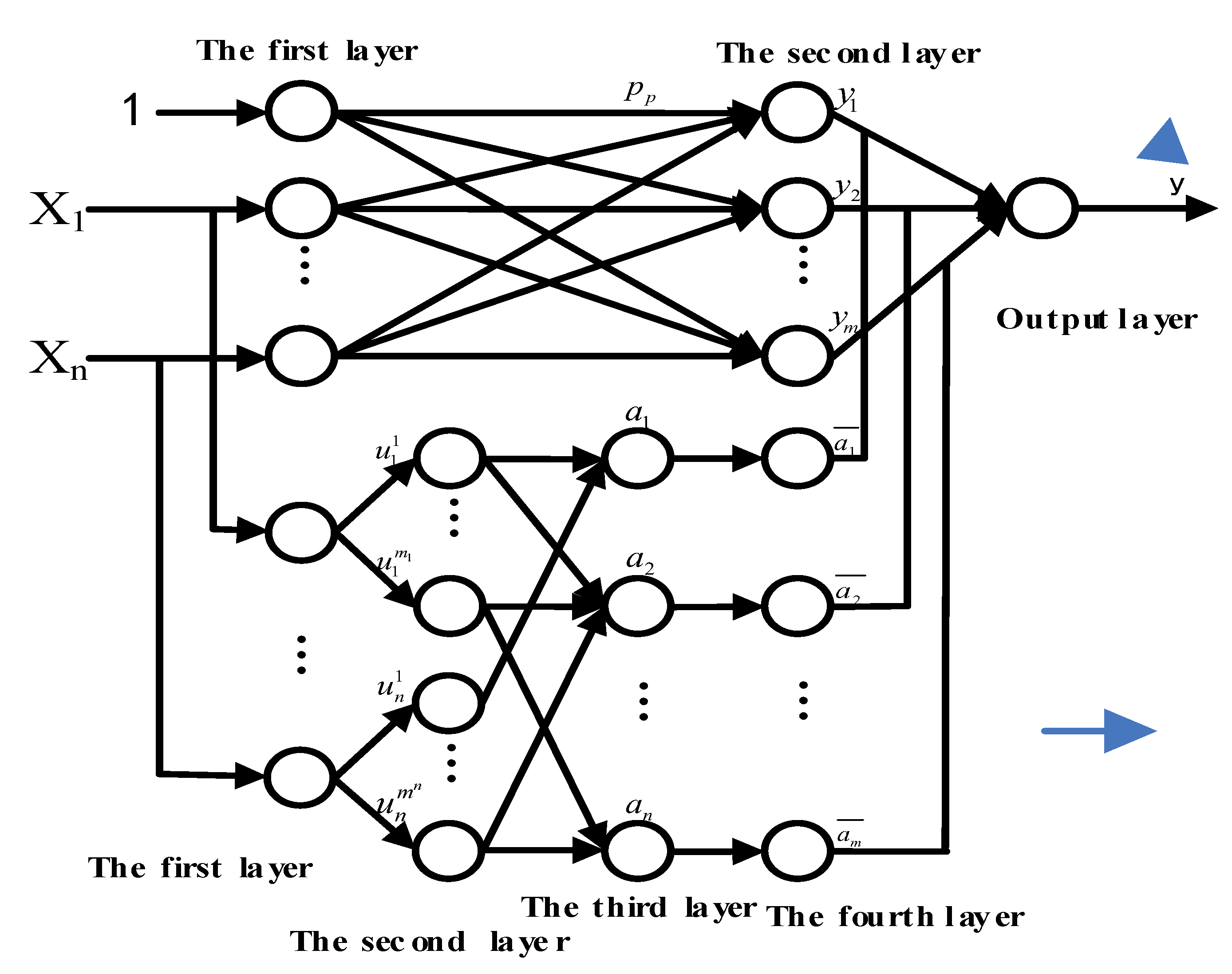
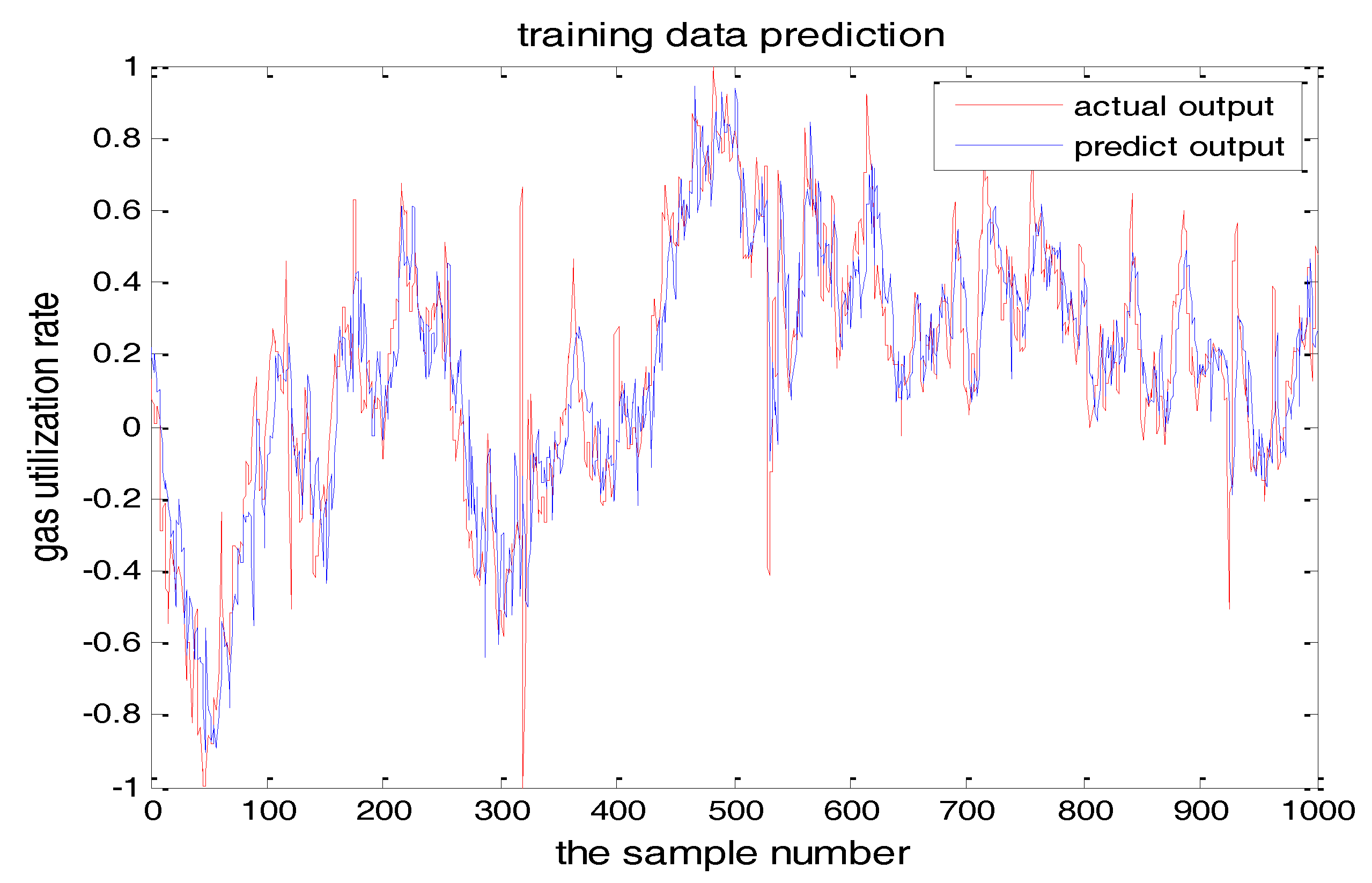
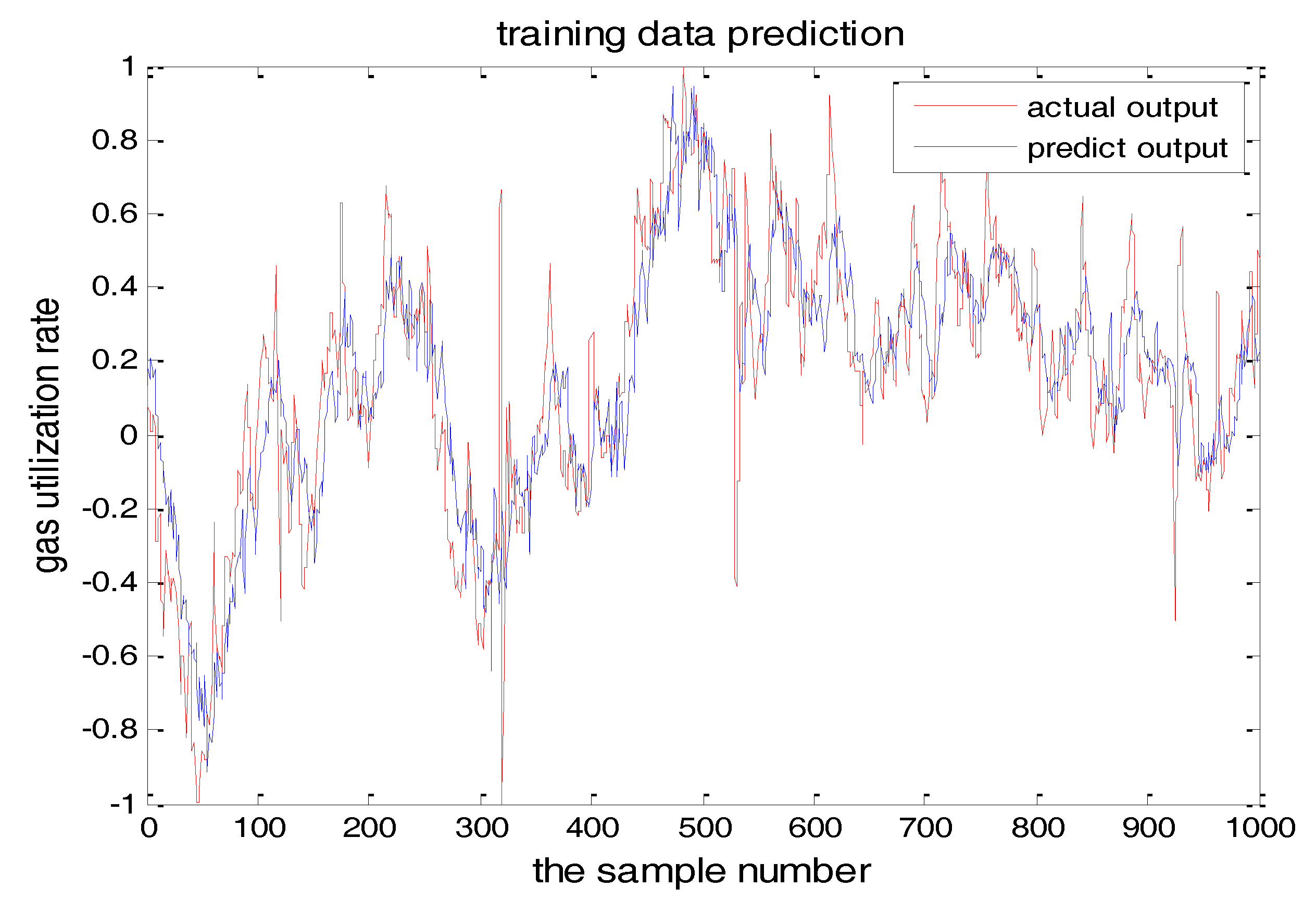
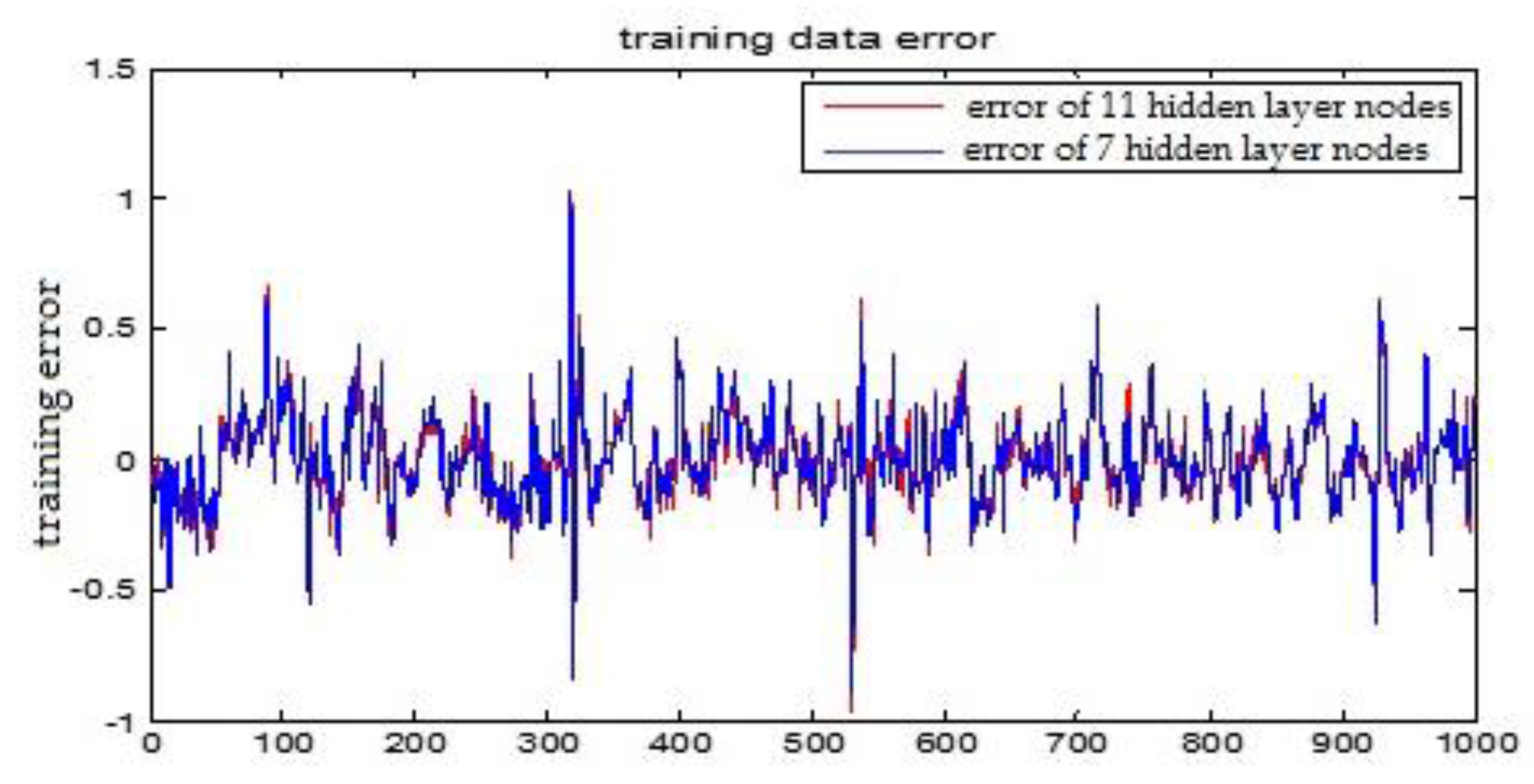
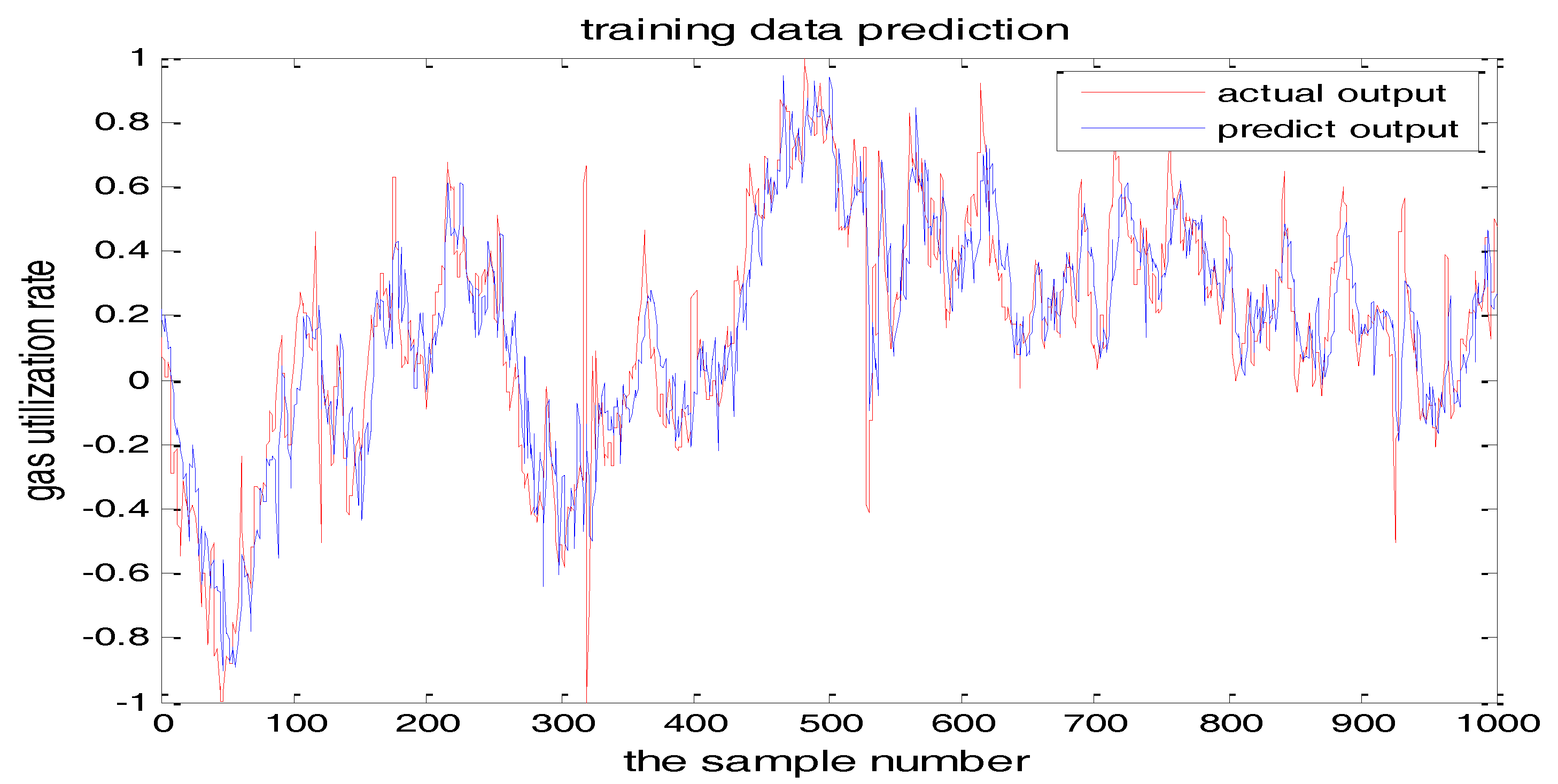

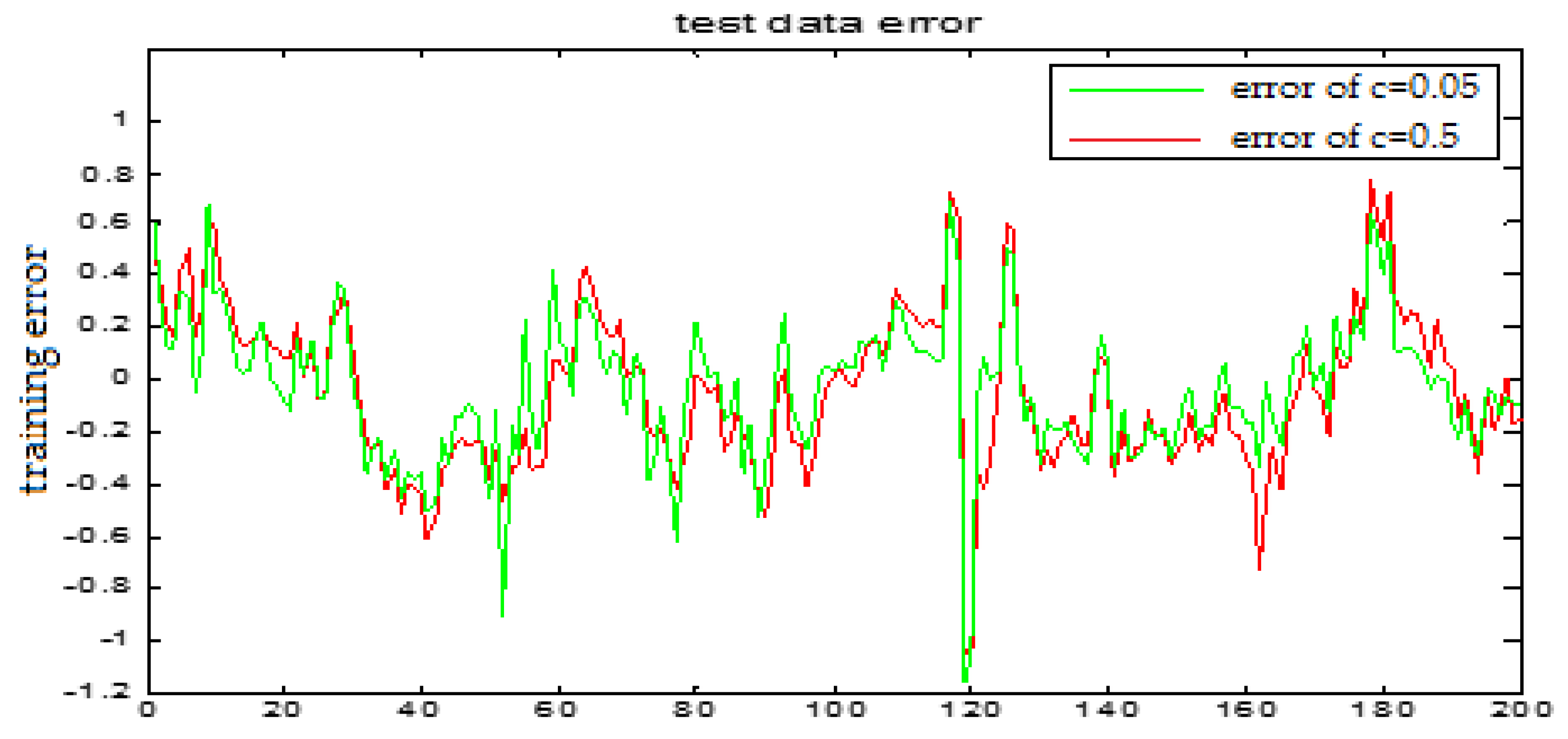

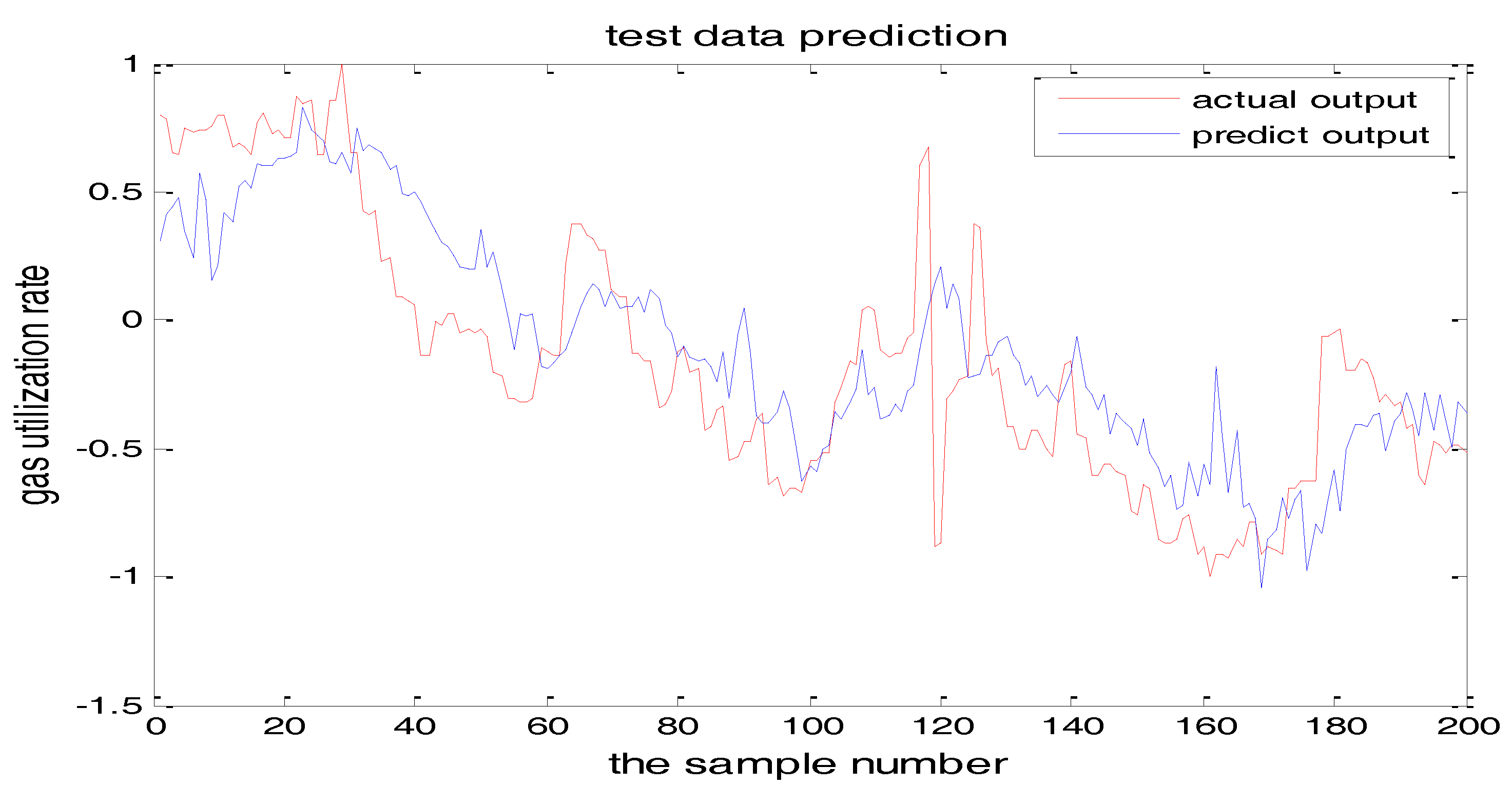
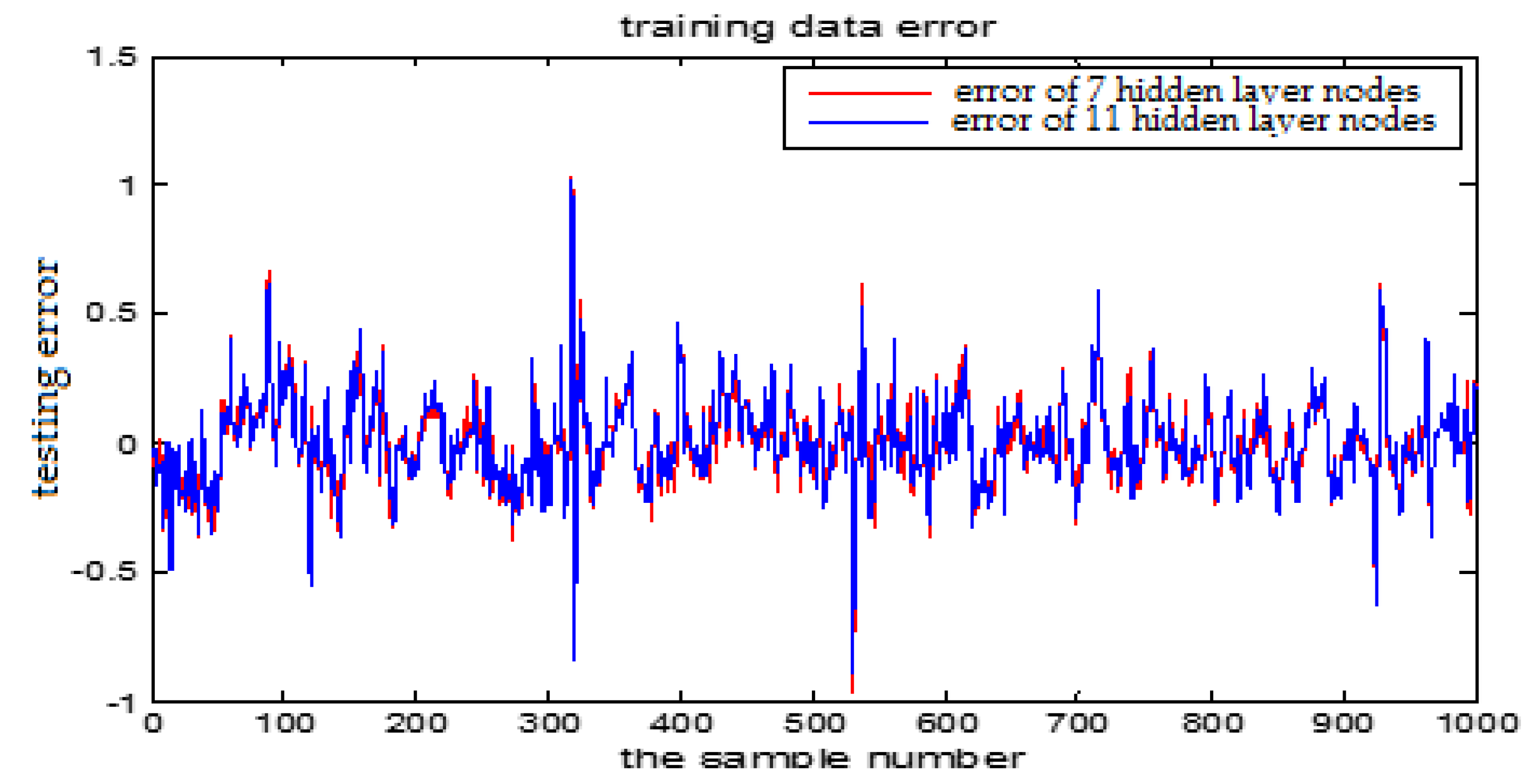

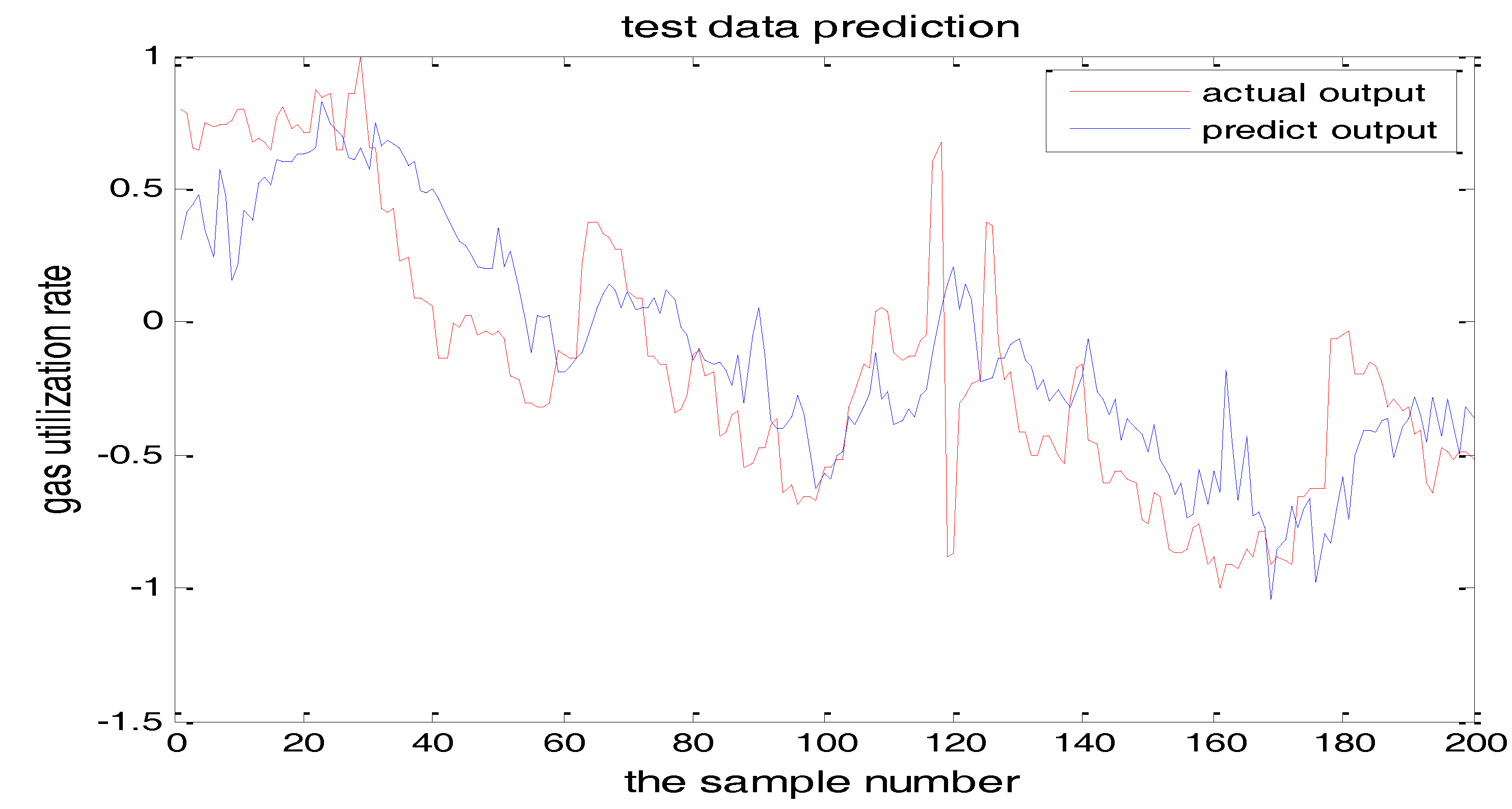
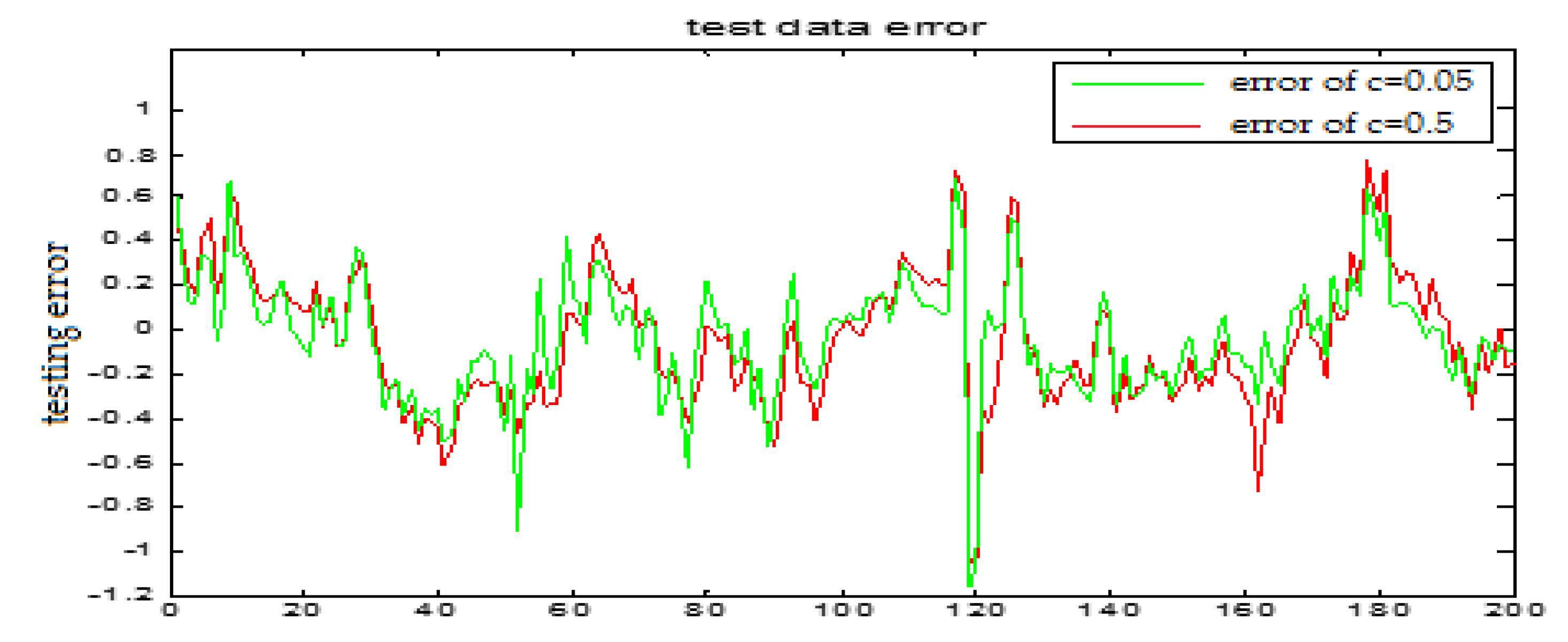
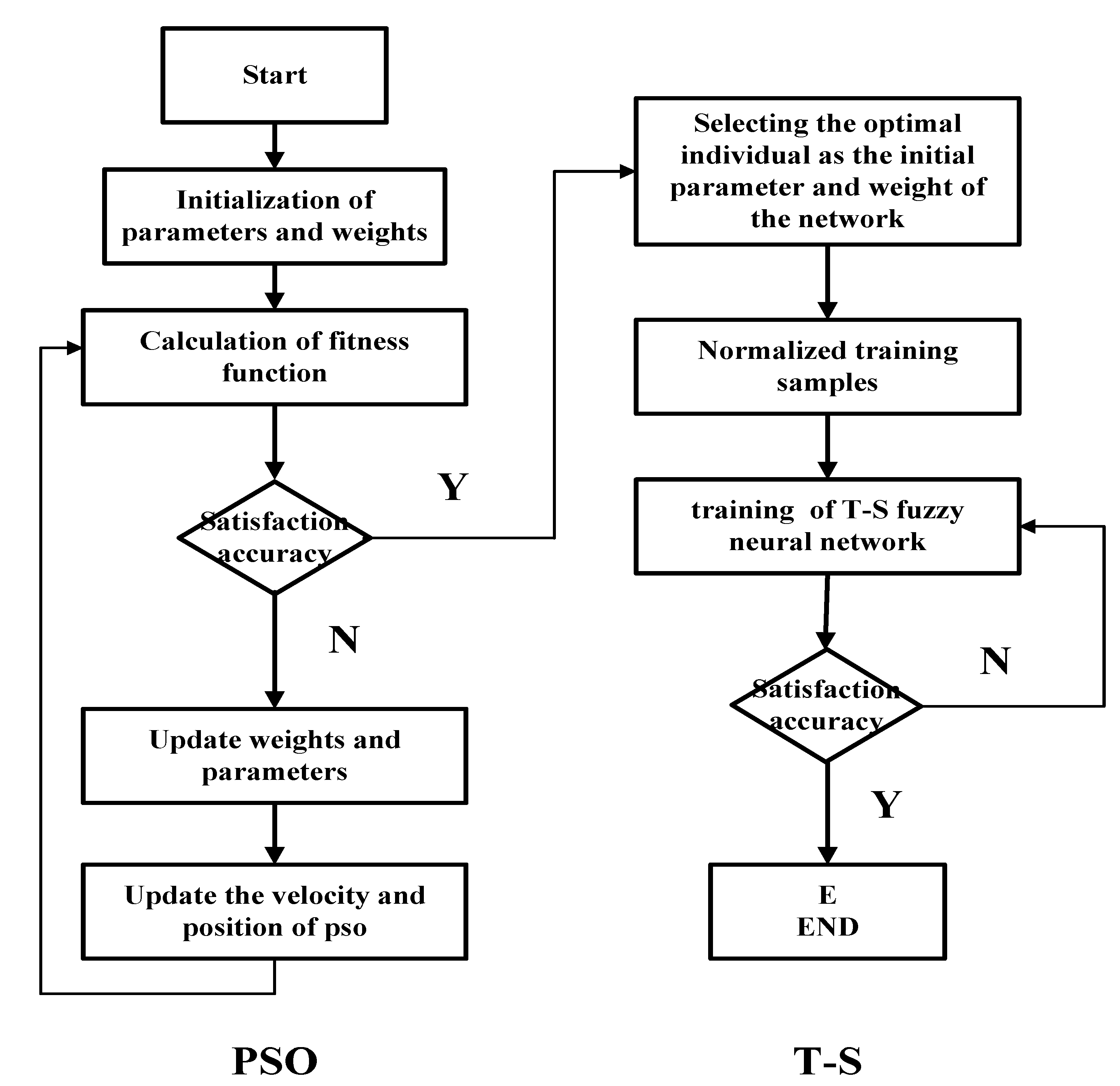
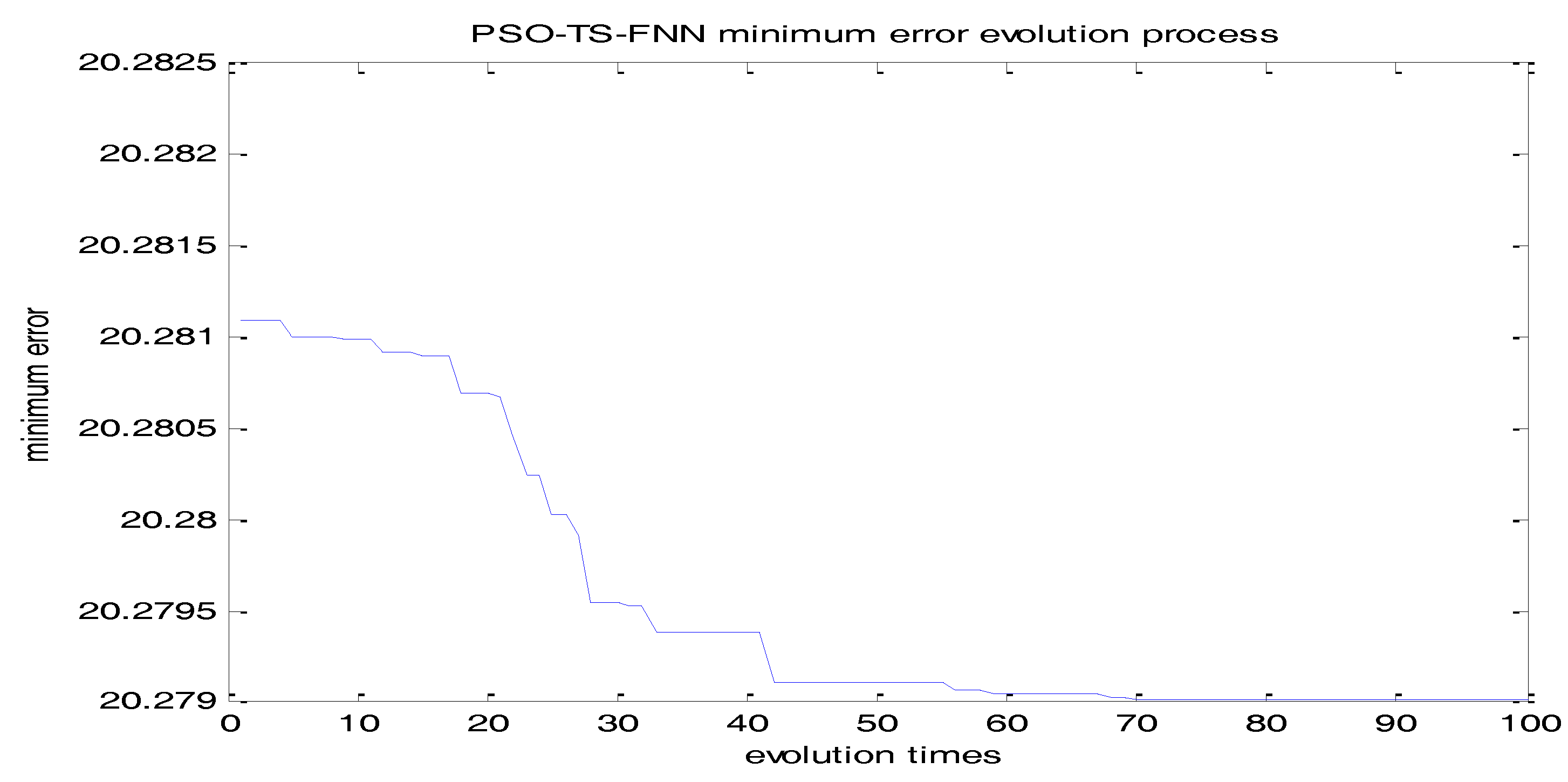
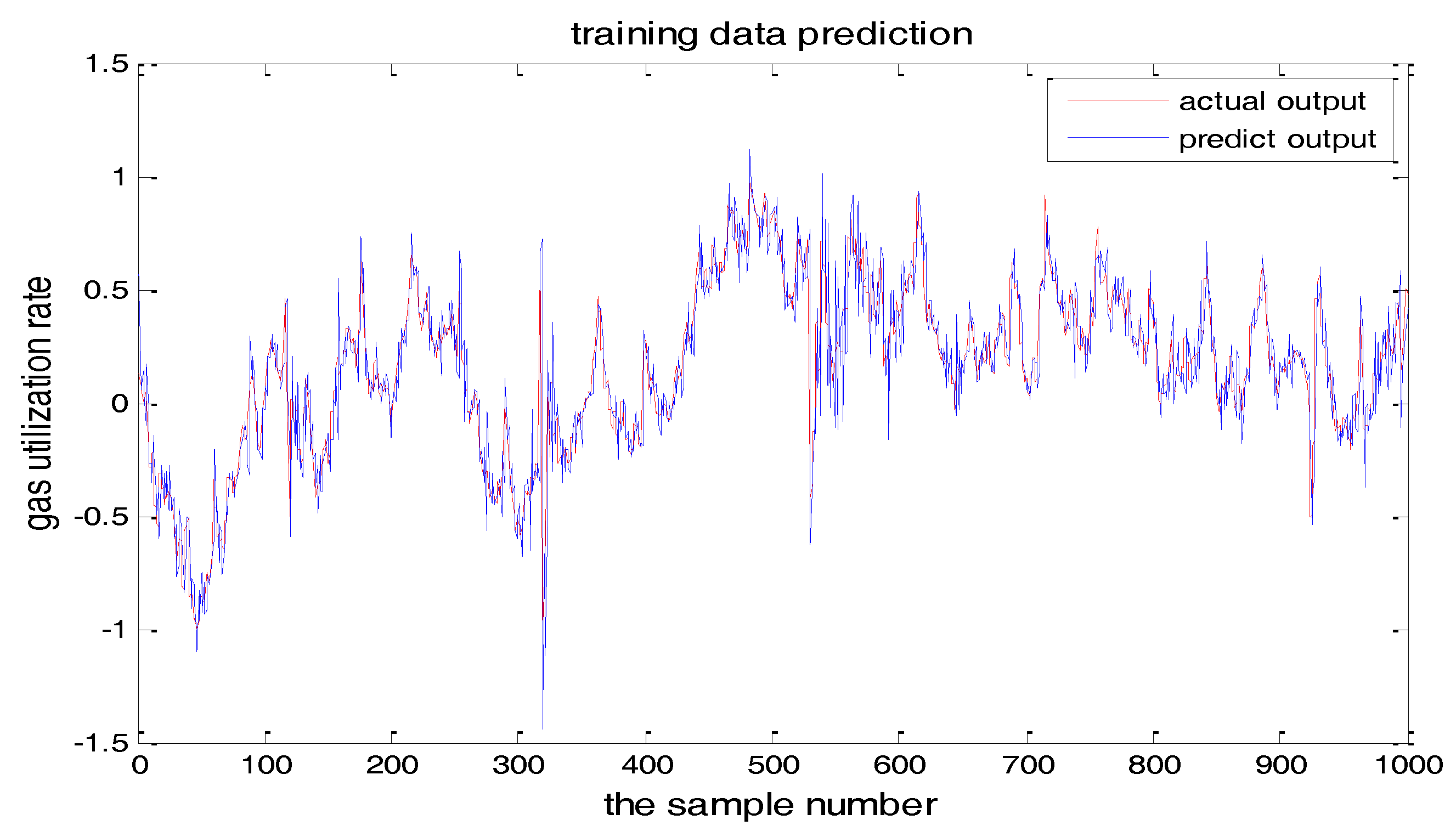


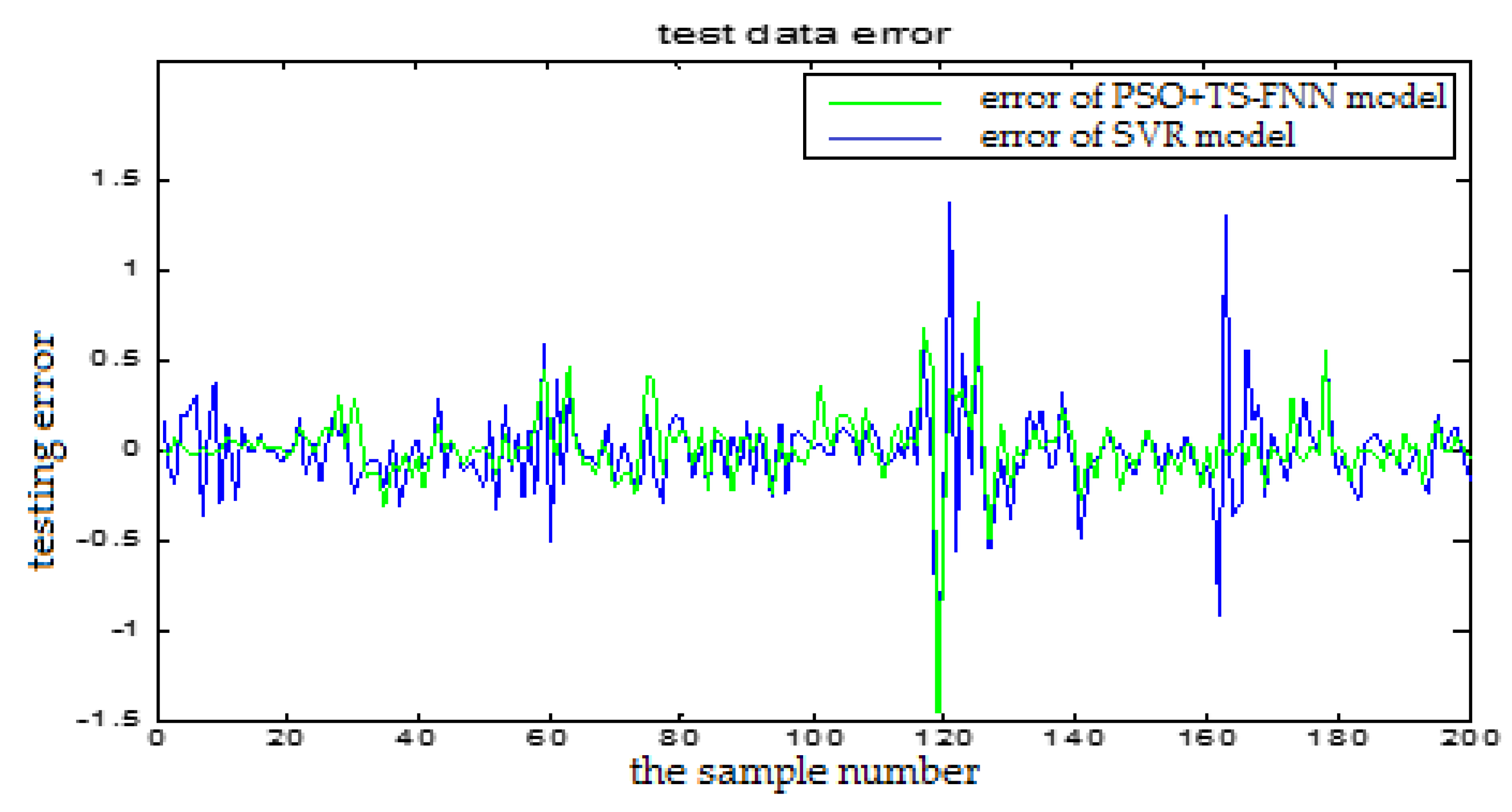
| Operating Parameters | Mutual Information |
|---|---|
| Blast volume | 0.6770 |
| Blast pressure | 0.6820 |
| Top pressure | 0.6253 |
| Top temperature | 0.9455 |
| Oxygen enrichment | 0.6732 |
| Gas utilization ratio | 2.9184 |
| Algorithm Model | AEA | MSE | ||
|---|---|---|---|---|
| Training | Testing | Training | Testing | |
| SVR | 0.2661 | 0.3856 | 0.0297 | 0.0679 |
| FNN | 0.1284 | 0.3064 | 0.0265 | 0.0599 |
| PSO-T-S FNN | 0.0894 | 0.2132 | 0.0210 | 0.0460 |
© 2018 by the authors. Licensee MDPI, Basel, Switzerland. This article is an open access article distributed under the terms and conditions of the Creative Commons Attribution (CC BY) license (http://creativecommons.org/licenses/by/4.0/).
Share and Cite
Zhang, S.; Jiang, H.; Yin, Y.; Xiao, W.; Zhao, B. The Prediction of the Gas Utilization Ratio based on TS Fuzzy Neural Network and Particle Swarm Optimization. Sensors 2018, 18, 625. https://doi.org/10.3390/s18020625
Zhang S, Jiang H, Yin Y, Xiao W, Zhao B. The Prediction of the Gas Utilization Ratio based on TS Fuzzy Neural Network and Particle Swarm Optimization. Sensors. 2018; 18(2):625. https://doi.org/10.3390/s18020625
Chicago/Turabian StyleZhang, Sen, Haihe Jiang, Yixin Yin, Wendong Xiao, and Baoyong Zhao. 2018. "The Prediction of the Gas Utilization Ratio based on TS Fuzzy Neural Network and Particle Swarm Optimization" Sensors 18, no. 2: 625. https://doi.org/10.3390/s18020625





